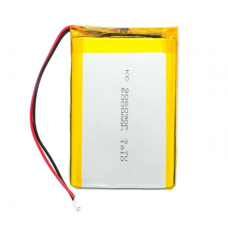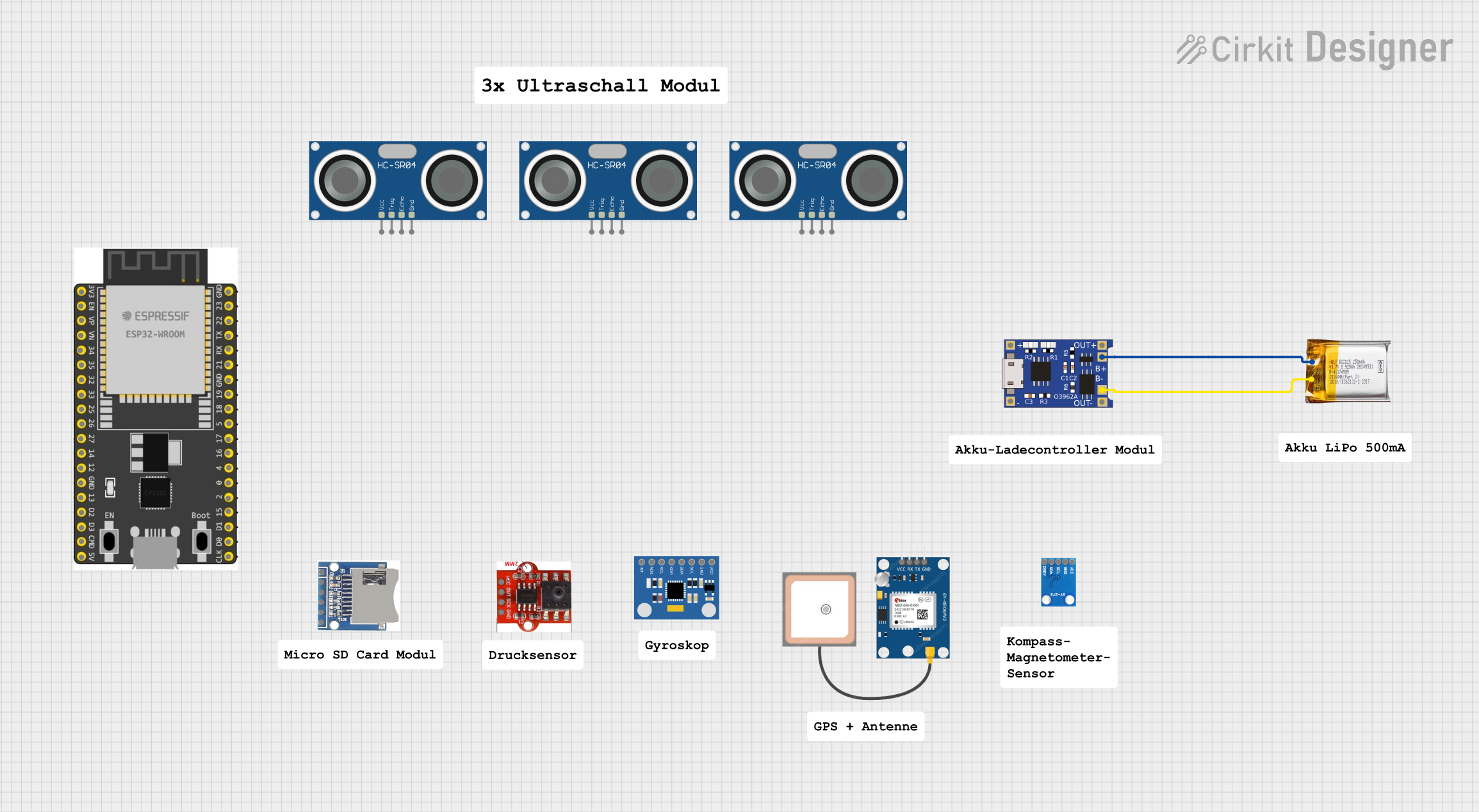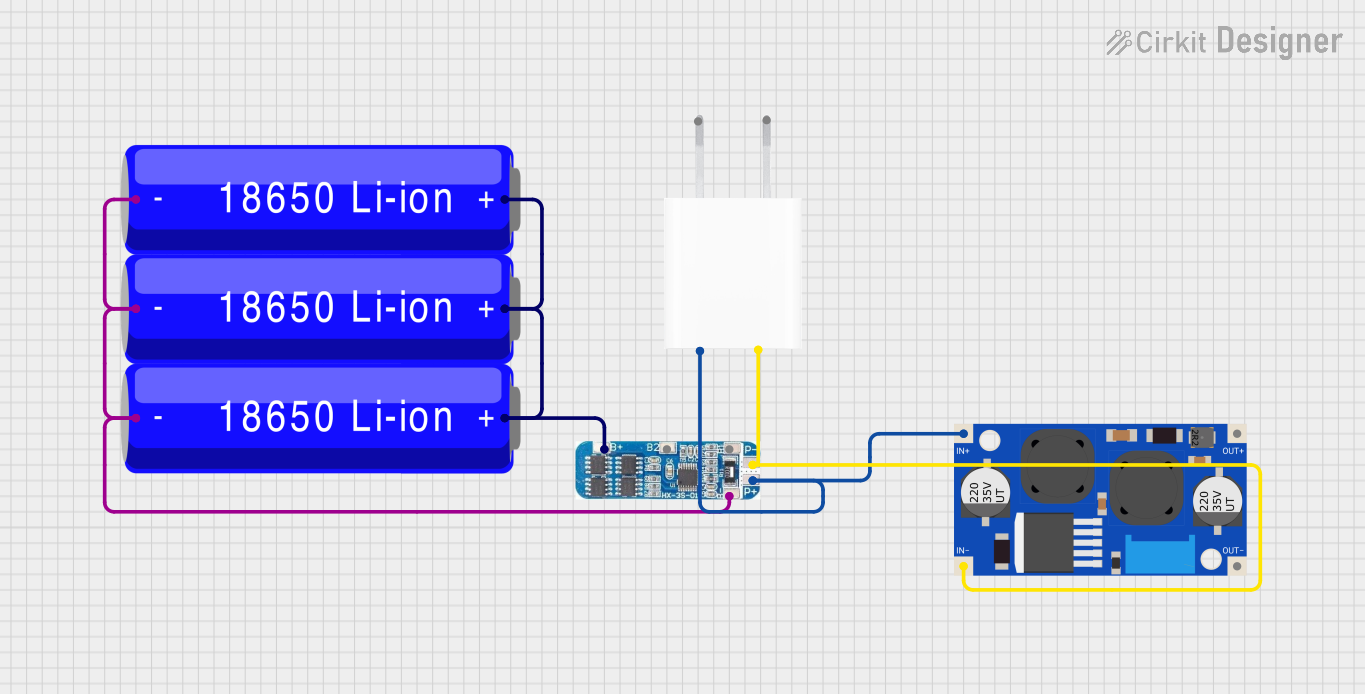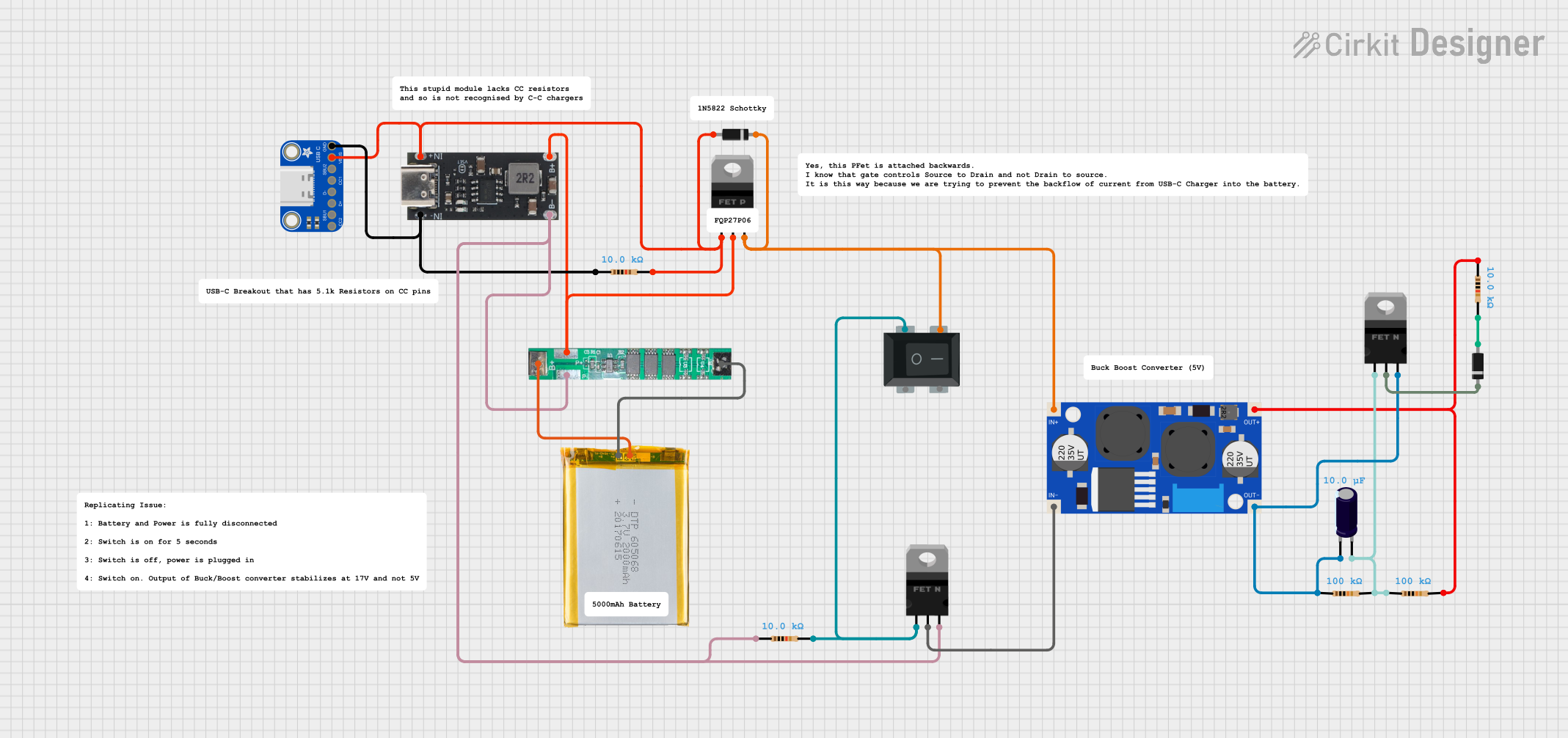
How to Use 3.7V LiPo Battery (6000mAh): Examples, Pinouts, and Specs

 Design with 3.7V LiPo Battery (6000mAh) in Cirkit Designer
Design with 3.7V LiPo Battery (6000mAh) in Cirkit DesignerIntroduction
The 3.7V LiPo Battery (6000mAh), manufactured by X2 Robotics (Part ID: LPJ906090), is a rechargeable lithium polymer battery designed for applications requiring lightweight, high-capacity power sources. With a nominal voltage of 3.7V and a capacity of 6000mAh, this battery is ideal for portable electronics, drones, RC vehicles, and IoT devices. Its high energy density and compact form factor make it a popular choice for projects where space and weight are critical considerations.
Explore Projects Built with 3.7V LiPo Battery (6000mAh)

 Open Project in Cirkit Designer
Open Project in Cirkit Designer
 Open Project in Cirkit Designer
Open Project in Cirkit Designer
 Open Project in Cirkit Designer
Open Project in Cirkit Designer
 Open Project in Cirkit Designer
Open Project in Cirkit DesignerExplore Projects Built with 3.7V LiPo Battery (6000mAh)

 Open Project in Cirkit Designer
Open Project in Cirkit Designer
 Open Project in Cirkit Designer
Open Project in Cirkit Designer
 Open Project in Cirkit Designer
Open Project in Cirkit Designer
 Open Project in Cirkit Designer
Open Project in Cirkit DesignerCommon Applications
- Portable electronic devices (e.g., tablets, handheld consoles)
- Drones and quadcopters
- RC vehicles and robotics
- IoT devices and wearables
- Backup power supplies for small systems
Technical Specifications
Below are the key technical details for the 3.7V LiPo Battery (6000mAh):
| Parameter | Value |
|---|---|
| Manufacturer | X2 Robotics |
| Part ID | LPJ906090 |
| Nominal Voltage | 3.7V |
| Capacity | 6000mAh |
| Maximum Charge Voltage | 4.2V |
| Minimum Discharge Voltage | 3.0V |
| Continuous Discharge Current | 3A |
| Peak Discharge Current | 6A (for up to 10 seconds) |
| Charging Current | 1C (6A max recommended) |
| Dimensions (L x W x H) | 90mm x 60mm x 9mm |
| Weight | ~120g |
| Connector Type | JST-XH or bare leads |
| Protection Circuit | Built-in overcharge, over-discharge, and short-circuit protection |
Pin Configuration
The battery typically comes with a JST-XH connector or bare leads. Below is the pinout for the JST-XH connector:
| Pin | Wire Color | Description |
|---|---|---|
| 1 | Red | Positive terminal (+) |
| 2 | Black | Negative terminal (-) |
Usage Instructions
How to Use the Battery in a Circuit
- Connection: Connect the red wire (positive terminal) to the positive input of your circuit and the black wire (negative terminal) to the ground. Ensure the polarity is correct to avoid damage.
- Charging: Use a LiPo-compatible charger with a constant current/constant voltage (CC/CV) charging profile. Set the charger to 4.2V and limit the charging current to 6A or less.
- Discharging: Ensure the load does not exceed the continuous discharge current of 3A. For short bursts, the battery can handle up to 6A for 10 seconds.
- Protection: The built-in protection circuit prevents overcharging, over-discharging, and short circuits. However, always use a battery management system (BMS) for added safety in complex circuits.
Important Considerations and Best Practices
- Avoid Overcharging: Never charge the battery above 4.2V, as this can cause overheating or damage.
- Avoid Over-Discharging: Do not let the voltage drop below 3.0V, as this can permanently reduce capacity.
- Storage: Store the battery at 3.7V to 3.9V in a cool, dry place when not in use for extended periods.
- Handling: Do not puncture, crush, or expose the battery to fire or water.
- Balancing: If using multiple batteries in series, ensure they are balanced to prevent uneven charging or discharging.
Example: Connecting to an Arduino UNO
To power an Arduino UNO with the 3.7V LiPo battery, you will need a DC-DC boost converter to step up the voltage to 5V. Below is an example circuit and code:
Circuit Diagram
- Connect the battery's positive terminal to the input of the DC-DC boost converter.
- Connect the output of the boost converter to the Arduino's 5V and GND pins.
Arduino Code Example
// Example code to read a sensor and send data via serial
// Powered by a 3.7V LiPo battery with a DC-DC boost converter
const int sensorPin = A0; // Analog pin connected to the sensor
int sensorValue = 0; // Variable to store sensor reading
void setup() {
Serial.begin(9600); // Initialize serial communication at 9600 baud
}
void loop() {
sensorValue = analogRead(sensorPin); // Read the sensor value
Serial.print("Sensor Value: ");
Serial.println(sensorValue); // Print the sensor value to the serial monitor
delay(1000); // Wait for 1 second before the next reading
}
Troubleshooting and FAQs
Common Issues
Battery Not Charging
- Cause: Charger not compatible or incorrect settings.
- Solution: Ensure the charger is LiPo-compatible and set to 4.2V with a current limit of 6A or less.
Battery Drains Quickly
- Cause: Over-discharge or high current draw.
- Solution: Check the load current and ensure it does not exceed 3A continuously. Avoid discharging below 3.0V.
Battery Swells or Overheats
- Cause: Overcharging, over-discharging, or physical damage.
- Solution: Stop using the battery immediately. Dispose of it safely if damaged.
No Output Voltage
- Cause: Protection circuit activated due to over-discharge or short circuit.
- Solution: Recharge the battery to reset the protection circuit.
FAQs
Q: Can I use this battery in series or parallel configurations?
A: Yes, but ensure proper balancing and use a battery management system (BMS) to prevent overcharging or over-discharging.
Q: How long does it take to fully charge the battery?
A: At a charging current of 6A (1C), it takes approximately 1 hour to fully charge. Lower currents will increase charging time.
Q: Is the battery safe for air travel?
A: Yes, but check airline regulations for lithium batteries. Typically, batteries under 100Wh are allowed in carry-on luggage. This battery is 22.2Wh (3.7V * 6Ah).
Q: Can I use this battery without a protection circuit?
A: The battery includes a built-in protection circuit, but for added safety, especially in complex systems, use an external BMS.
By following these guidelines, you can safely and effectively use the 3.7V LiPo Battery (6000mAh) in your projects.